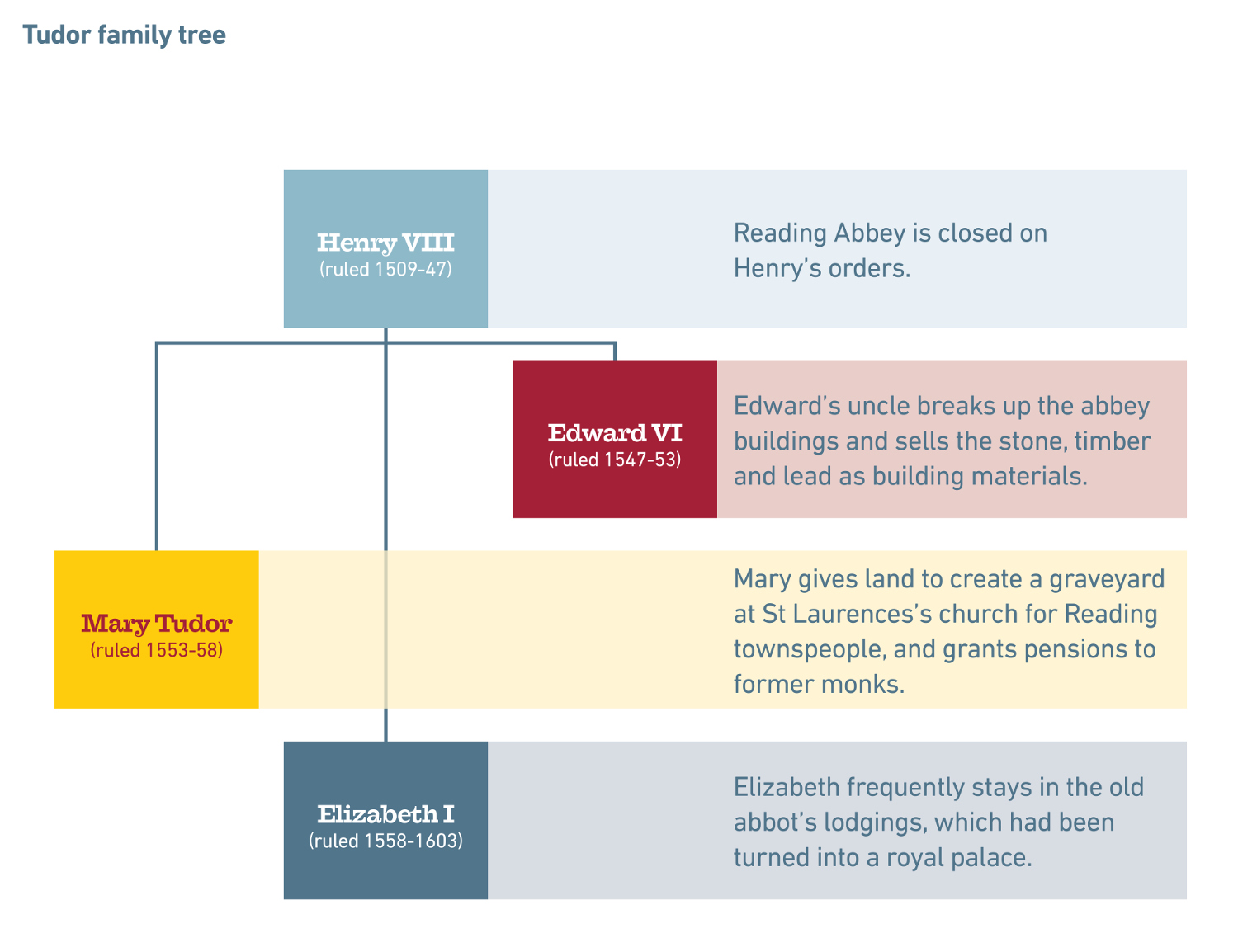The Abbey Gateway divided the monks’ private living quarters from the more public areas of the abbey. In the 1560s, Queen Elizabeth I turned the abbot’s house, which stood just through the gateway, into a royal palace. After Elizabeth’s death, the palace fell out of use and eventually new houses were built alongside the gateway. In the 18th century one of them was home to the Reading Ladies’ Boarding School, which used the gateway as a classroom. From 1785-86 a particularly talented pupil studied here: the future novelist Jane Austen.
In 1861 the Gateway collapsed in a storm, shortly after funds had been raised for vital conservation. Instead the Gate had to be substantially rebuilt. This work was completed by Sir George Gilbert Scott, a Victorian architect known for his Gothic Revival work. He also designed Reading Gaol within the Abbey Quarter. The carvings on the outer walls span the whole life of the building. The Gateway was extensively restored in 2017-8 with support from the Heritage Lottery Fund and is now used by Reading Museum as part of its hands-on learning programme for local schools.
Digging Deeper - What happened inside the gate?
In the abbey period there was a small room on the ground floor where a porter could shelter from the weather, watch for visitors and keep the inner precinct secure especially during the annual fairs. There is a reference to the porter's lodging in a 1650 parliamentary survey of the abbey site.
The functions of the upper spaces in a medieval gatehouse depended on the needs of the abbey at a given time. The large open room on the first floor of the gate was a flexible space and over time could have been a court, chapel, guest room and lodgings for one of the abbey's officials. There is no surviving record of the actual uses of these spaces.
Hugh Faringdon’s execution
Hundreds of monasteries and nunneries were closed in England and Wales in the 1530s, as King Henry VIII declared himself head of the church and absorbed the wealth of the abbeys and priories into his own treasury. Historians call the closure of the monasteries and nunneries the Dissolution. In 1539 on the orders of Henry Reading Abbey was closed. Henry took the abbey’s valuable possessions. The monks had to leave their former home.
In November 1539, a gallows was set up near the west door of the abbey church, not far from the Abbey Gateway. Reading’s last abbot, Hugh Cook of Faringdon, was tied to a hurdle harnessed to a horse, and paraded through the streets of Reading to the gallows. He was executed alongside two monks: John Eynon (priest of St Giles) and John Rugg. Hugh had been convicted of treason so his punishment was hanging, drawing and quartering.
When Henry closed the monasteries and nunneries, the majority of monks and nuns were allowed to go in peace, but Hugh and the abbots of Colchester and Glastonbury Abbeys were executed. They were singled out because they resisted the king’s orders. In arguing that the king did not have the right to close their abbeys they were questioning his authority. Henry saw this as disloyal and treasonous.

Martyrdom of Hugh Faringdon, Last Abbot of Reading in 1539 by Harry Morley, 1917
The aforesaid Hugh Abbot of the Monastery of Reading, John Eynon and John Rugge should be taken to the King’s gaol of Reading. And they should be separately dragged through the middle of the town of Reading to the place of execution and there hanged on the gallows. And each should be taken down while living and laid on the ground, and their bellies taken out and burned while they are alive, and their heads cut off. And their bodies shall be cut into four parts. And their heads and their quarters shall be placed wherever the lord King should wish.
- Report of the sentence at Hugh of Faringdon’s trial

Elizabeth I (ruled 1558-1603) Artist unknown, painted about 1575 (object no.
Gateway to a Tudor Palace
When Henry VIII died in 1547, his son Edward became king. He was too young to rule, so the Duke of Somerset ruled for him as Lord Protector. On Somerset’s orders the abbot’s lodgings were turned into a royal palace, but lead from the roofs of other abbey buildings was stripped off and sold. Good quality stone was taken away and reused at Reading and beyond. The flint cores of the church walls were left standing.
Edward's sister Queen Elizabeth I was a regular visitor to Reading. She stayed in the former abbot’s lodgings, which had been converted into a royal palace. The Abbey Gateway had been retained as the entrance to the royal residence.
Royalist troops occupied Reading in 1642, and used the walls of the ruined church and dormitory to create fortifications overlooking the town and the river. In some places holes were smashed through walls to give a clear line of fire. The old abbot’s lodgings were damaged too, and were not used as a royal palace again.






